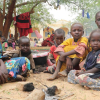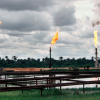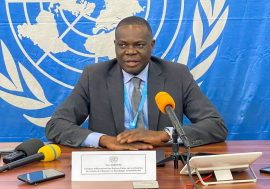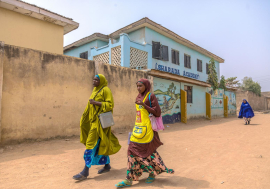Sahel: surviving the lean season
Sahel: surviving the lean season
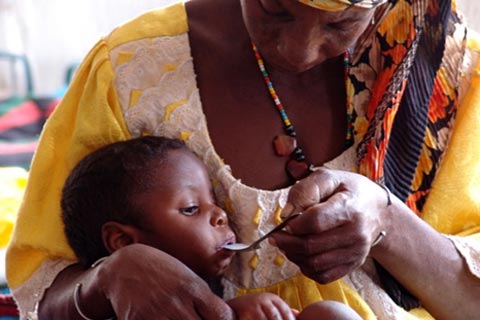 Mother feeds her child in Niger: Across the country, and in other parts of the Sahel as well, millions are facing severe hunger, worsened by drought and political turbulence.
Mother feeds her child in Niger: Across the country, and in other parts of the Sahel as well, millions are facing severe hunger, worsened by drought and political turbulence.In Africa’s Sahel region, even in years of adequate rainfall food insecurity is usually high. Now, as the region enters the precarious “lean season” (the period between harvests that lasts from May to August), the problem is expected to get worse. In recent months, rains have been erratic and scarce, in turn significantly diminishing the crops produced by farmers. Entire communities are without sufficient food reserves to survive until the next harvests in September. Ten million people in eastern Mali, northern Cameroon, Chad and Niger could go hungry, according to the latest estimates of the UN World Food Programme (WFP). “People have lost crops, livestock, and the ability to cope on their own,” confirms Thomas Yanga, the agency’s director for West Africa.
In Chad, poor harvests led to a 34 per cent decrease in cereal production. More than 2 million people ― including 1.4 million in the country’s western Sahelian region alone ― are in urgent need of assistance. UN agencies are distributing food to the most vulnerable. In many villages residents have left in search of work elsewhere, in what seems to be a common trend across the region. Late in May, at the end of a three-day visit in the country’s most affected areas, the UN relief coordinator, John Holmes, warned that “the situation is alarming, particularly given that the lean season has only just started.”
In northern Cameroon, months of drought resulted in a 19 per cent decrease in the country’s cereal harvest. Until April 2011, more than 300,000 people will likely have to rely on a WFP-run emergency operation. In Mali, 258,000 vulnerable persons are already receiving food assistance.
Niger’s plight
With 7.1 million people (almost half the country’s population) at risk of going hungry ― according to a survey published by the government in May ― Niger is facing the biggest risks. So far, 3.3 million people are believed to be severely affected by food shortages and 6,000 villages are facing an “acute food crisis,” the UN humanitarian coordinator for Niger told reporters at a press conference in Geneva in early April. According to a representative of the UN Children’s Fund (UNICEF), “The most critical regions include Maradi, Zinder and Diffa, though towns such as Tillabery, Agadez and the capital city, Niamey, are themselves not immune.”
Last year’s cereal production declined by 31 per cent, causing a deficit of 410,000 metric tonnes. Fodder production was down by 67 per cent, posing a serious threat to national livestock. On average, food prices are higher and increasingly unaffordable for a majority of people.
“This year’s harvest was disastrous,” the village chief of Angalnadinao in Niger's Zinder Region told a reporter working with UNICEF in May. “No cowpeas, no millet, no peanuts – nothing, absolutely nothing, was harvested. A total crop failure,” he complained. Speaking to the UN relief coordinator recently, the village chief of Dalli, also in Zinder Region, told a similar story: “The drought destroyed everything. Our food reserves are empty, and we can barely feed our animals. We had to sell most of our livestock.”
In the region of Maradi, home to 20 per cent of Niger’s population, the situation is equally dramatic. “Right now, we cannot afford more than one meal a day. We used to have three meals a day,” Abdou Garba, a farmer from Tara, told the Agence France Presse news agency. “We are hungry, our cattle is hungry. What is happening right now is exactly what happened in 2005,” another village chief concluded, referring to a previous food crisis when around 10 million people in the Sahel suffered from famine.
According to news report, the food crisis at home is forcing many, including women and children from Niger’s rural areas, to migrate to cities and to cross into neighbouring countries. In the village of Angalnadinao where the situation has never been this bad, 60 out of 400 residents have migrated to Nigeria, hoping to find means of survival. In the Nigerian state of Katsina, correspondents report, newcomers are selling water and tea to make money while others are seeking shelter with local families.
Faced with the crisis, the military government that took power following a coup on 18 February has quickly declared a “state of critical food insecurity.” On 10 March, it launched an appeal for urgent assistance and drew up a plan to assist 3.4 million people. Such a swift response is notable. Unlike in 2005, when then President Mamadou Tandja refused to admit that a crisis was taking place ― contributing to belated assistance to the victims ― the new political leadership has been faster in recognizing the reality and the scale of the problem.
Early in April, humanitarian actors stepped up their mobilization too. They launched an appeal, asking for US$190 mn. So far, donors have not reacted fast enough. Out of the total amount, $22 mn is earmarked for assistance to children suffering of malnutrition. But on 3 June, UNICEF announced it had received only $7.4 mn. The agency called for urgent contributions from donors.
Natural and political disaster
While this year’s food crisis in the Sahel has already reached critical proportions, its scenario is not uncommon. Over the past five decades, persistent droughts have led to numerous episodes of famine. Most people in the region rely on rainfed agriculture for subsistence and thus are vulnerable to variations in rainfall. Although inclement weather conditions rank prominently in most analyses, questions are being raised over their political dimensions.
“Natural causes alone cannot explain recurring food crises in the sub-region,” notes a 2006 policy brief by Actionaid International, an international anti-poverty agency. In regions where water is a key challenge to food production, beyond sporadic crisis management, investments and sound water management policies are needed. Yet, regrets Actionaid: “Throughout the region, economic policies facilitate more imports of foreign food products which are generally subsidized. This results in a situation of unfair competition, which is a major constraint to the development of local food sectors.”
A much-needed policy shift is further complicated by political instability in some of the worst-affected countries. In Niger, the humanitarian situation is linked to the political one. In addition to the previous regime making assistance difficult and slow, months of political turbulence before the coup in February has allowed the food shortage to worsen, far from the public eye. Now, unless the food crisis is solved, the transition to a democratic order risks being derailed.
In neighbouring Chad, although massive revenues from oil exploitation have recently provided the government with additional financial resources, addressing the food shortages is yet to become a budgetary priority. Instead, military expenditure is the main spending category as the country faces threats from various rebels groups. Much like in Niger, solving the political crisis in Chad could help save those at risk of going hungry in coming weeks and months.
— Africa Renewal online






